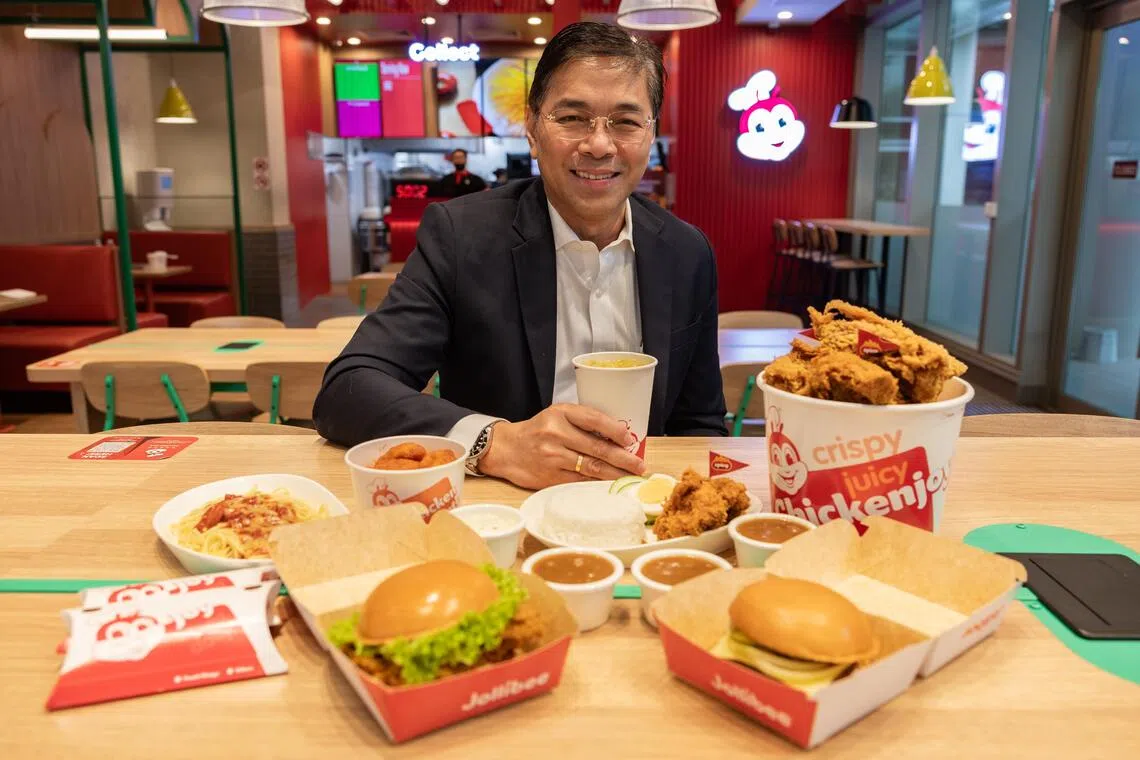CEO Insights
How Philippines’ Jollibee has rewritten what it takes to thrive in S’pore’s tough fast-food market
Sign up now: Get ST's newsletters delivered to your inbox

Jollibee’s president and head of international business Dennis Flores said Singapore led Jollibee’s international performance in the first half of 2025.
ST PHOTO: BRIAN TEO
Follow topic:
- Singapore is Jollibee's toughest, but fastest-growing and most innovative, market, driving efficient operations and menu innovation for global expansion.
- Jollibee's Singapore success stems from consistent quality, menu adaptations like Spicy Chickenjoy, and efficient supply chain and labour management to counter high costs.
- It plans to expand in Singapore with 4-5 new stores yearly, leveraging local demand and existing investments like Tiong Bahru Bakery.
AI generated
SINGAPORE – In the 12 years since Jollibee Foods Corporation arrived in Singapore, the Philippine fried chicken giant has quietly rewritten what it takes to survive and thrive in one of the world’s most cut-throat fast-food markets.
Today, Singapore is more than just one of Jollibee’s fastest-growing international markets.
Amid the intense competition, high costs and demanding customers and employees, the Republic has also become a test bed that forces Jollibee to optimise operations, innovate its menu and elevate its service, lessons that shape the fast-food chain’s playbook for new markets from Britain to Spain.
“Singapore is the toughest market in the world. But it’s also our fastest-growing and most innovative (market),” Jollibee’s president and head of international business Dennis Flores told The Straits Times in an interview.
“The expectations of customers, landlords and even employees are just on another level.
“But that’s why Singapore is so important. What we learn here – how to run efficiently, innovate and serve customers better – helps us everywhere else. If you can succeed here, you can succeed anywhere.”
Jollibee has certainly written a strong growth story in Singapore since operating here in 2013.
The Republic led Jollibee’s international performance in the first half of 2025, surpassing the fast-food chain’s double-digit global sales growth on the back of menu innovations, strong delivery demand and wider store coverage, Mr Flores said.
The chain currently operates 26 outlets in Singapore, including stores opened during the pandemic.
Four new outlets opened in 2025, including at the National University of Singapore and Punggol Digital District. A Hougang Mall outlet is due to open in December.
“Our brand is resonating very well with the locals here, so we are going where our customers want us to be,” Mr Flores said, adding that 80 per cent to 90 per cent of Jollibee’s customers in Singapore are locals, and not just members of the Filipino community who supported the brand when it first opened.
Staying ahead in Singapore
In Singapore’s competitive market, consistency in taste and quality is what keeps Jollibee ahead.
“Whether it’s a health trend or new competitor, there will always be demand for great-tasting fried chicken that is prepared fast and served with a smile,” Mr Flores said, adding that most of Jollibee’s customers patronise it because “they love the taste of our fried chicken”.
“We want to be the first brand customers think of when they crave fried chicken. So wherever you go in the world, we make sure our Chickenjoy tastes the same.”
That belief is at the core of Jollibee’s global strategy and it is especially true in Singapore, where consumers are highly discerning when it comes to taste, he said.
One way to keep them hooked is to make sure the menu is stacked with options that suit local tastes.
Jollibee’s Spicy Chickenjoy, which started out in Singapore, is “one of the spiciest in the world”, while Nasi Lemak Chickenjoy, introduced in 2020, has remained in demand.
In 2025, Jollibee Singapore also rolled out original and spicy nuggets, loaded fries and a coco pineapple pie, products shaped by local insights.
“Singapore is always the forerunner in menu innovation and operations. What we do here becomes a pilot for other outlets worldwide,” Mr Flores said.
But operating successfully in Singapore goes well beyond taste and options.
The other part of the equation is wrestling with some of the world’s highest rentals, labour costs and competitive pressures.
Customers are also fiercely value-conscious.
“People here still expect $5 meals, even though most fast-food meals cost $8 to $10 today. That’s the reality we operate in,” he added.

In Singapore’s competitive market, consistency in taste and quality is what keeps Jollibee ahead.
PHOTO: ST FILE
To remain competitive, Jollibee operates one of its leanest and most efficient markets in Singapore.
Supply chain is its largest cost component. Most raw materials are sourced locally or from neighbouring countries to maintain quality and ensure supply.
As more stores open, economies of scale allow Jollibee to negotiate better with suppliers.
“With higher volume, fixed costs go down as a percentage of sales. Scale solves a lot of the supply chain pressure,” said Mr Flores.
Labour is the second-largest cost.
“In the Philippines, most workers are full-time. Here, flexibility matters, such as the availability of part-time roles, flexible shifts and work-life balance,” said Mr Flores.
He added that Jollibee adjusts its compensation and staffing model to reflect what Singapore workers prefer and keep staff turnover low.
Jollibee Singapore currently employs around 300 people.
Each store typically has around 20 employees, although more self-service kiosks are being set up, especially at the newer outlets, to boost labour efficiency.
Mr Flores said Jollibee also “takes good care of staff so they don’t leave”, and regularly organises engagement activities, with team-building efforts and a family-oriented work culture to help keep turnover low.
“We may not always offer the highest pay, but we treat people like members of the family,” he said.
“In Singapore, that makes a difference. Staff don’t like to feel like they are just another cog in the machine.”
Managing landlords is another key part of operating in Singapore’s high-cost retail landscape. Lease contracts here typically run on a 3+3 year cycle – a three-year contract with an option to renew for another three years, said Mr Flores.
While the terms are largely standard and “to a large extent beyond our control”, the chain negotiates where possible.
Some landlords, recognising Jollibee’s ability to bring footfall and new traffic to their malls, offer initial concessions, such as lower percentage rents in the first six months if a trade area is still developing.
But location choice is guided less by landlord relationships and more by customer demand.
“We don’t necessarily go with the same landlord across malls. We pick the best location for convenience and accessibility,” he said, noting that the brand recently exited Changi City Point after a change in mall ownership and the expiry of its contract. It has started operating in universities like NUS and new developments such as the Punggol Digital District.
More expansion on the cards
Singapore is actually Jollibee’s first international market.
The chain first opened in Singapore in 1984 at Roxy Square in Katong, but the store closed down in 1986.
The brand reopened in 2013 on level six of Lucky Plaza, drawing mostly Filipino crowds willing to queue for hours.
Its success led to a second outlet in the mall’s basement, a more accessible site that began attracting a broader mix of diners, including a rising number of Singaporeans trying Chickenjoy for the first time.
That encouraged Jollibee to expand into neighbourhoods and the heartland.
Its Square 2 outlet in Novena recorded more than 60 per cent local patronage on opening day, and a subsequent opening in Bedok Mall strengthened that reach.
Mr Flores believes there is still room to grow in Singapore. Over the next three to five years, Jollibee sees enough demand here to sustain the opening of four to five new stores each year.
“McDonald’s operates around 130 stores here. KFC has more than 70. We have only 26. We are still very small.”
Listed on the Philippine Stock Exchange, Jollibee had a total of 1,759 stores worldwide as at Dec 31, 2024.
But it has also expanded its empire by investing in other food and beverage brands, including home-grown Singapore names like Tiong Bahru Bakery and Common Man Coffee Roasters, through its majority-owned private equity fund Titan Dining.
In 2024, Jollibee also fully acquired Hong Kong dim sum chain Tim Ho Wan, which has outlets in Singapore, paying around $20 million for the shares it did not fully own. In 2019, it acquired loss-making coffee chain The Coffee Bean & Tea Leaf for around $478 million.
In the first nine months of 2025, Jollibee reported revenues totalling 224.2 billion pesos (S$5 billion), an increase from 196.2 billion pesos in the first nine months of 2024. Net profit rose to 8.6 billion pesos for the period, compared with 8.5 billion pesos in the same period in 2024.


